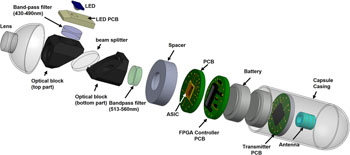Fluorescent Imaging Expands Capabilities of Ingested Video-Pills
By HospiMedica International staff writers
Posted on 06 Jan 2016
An innovative miniaturized wireless endoscope video capsule that utilizes fluorescence imaging (FI) could improve detection of cancer in the throat and digestive system.Posted on 06 Jan 2016
Developed by researchers at the University of Glasgow (United Kingdom), the new video endoscopy pill exploits a phenomenon where certain molecules emit light when they are illuminated by specific wavelengths outside the visible spectrum. But while current diagnostic FI devices are expensive, bulky, and consume substantial power, the miniaturized wireless FI version has low power consumption, thanks to a state-of-the-art complementary single photon avalanche detector (SPAD) imaging array, miniaturized optical isolation, and wireless technology.

Image: Exploded diagram of the FI endoscopy video pill (photo courtesy of the University of Glasgow).
The crucial component of the video-pill design is the SPAD array, which generates a pulse of current every time it is hit by a photon of the emitted fluorescent light, generated when a simple LED light illuminates the suspected tumor in the 468 nm band. According to the researchers, the capsule can be successfully used to image tissue autofluorescence and targeted fluorescence via fluorophore labeling. The system is also small enough and power-efficient enough to image the entire human gastrointestinal (GI) tract for up to 14 hours.
To demonstrate the performance of the capsule, the researchers imaged fluorescence phantoms incorporating principal tissue fluorophores (flavins) and absorbers (hemoglobin), which mimic how cancers are affected by fluorescence in the intestines, the bowel, and the esophagus. They also demonstrated the utility of marker identification by imaging a 20 μM fluorescein isothiocyanate (FITC) labeling solution on mammalian tissue. The study describing the FI capsule and the validation process was published on December 18, 2015, in Nature Scientific Reports.
“It’s a valuable new technique which could help clinicians make fewer false positives and negatives in cancer diagnosis, which could lead to more effective treatment in the future,” said lead author electrical engineer Mohammed Al-Rawhani, PhD. “The system could also be used to help track antibodies used to label cancer in the human body, creating a new way to detect cancer.”
“We’ve played an important role in developing the technology behind video-pill systems, and this is an exciting new development, which offers a valuable new resource for gastrointestinal imaging,” added senior author Prof. David Cumming, PhD, chair of the department of electronic systems. “There’s still some way to go before it will be ready for commercial production and clinical use, but we’re in early talks with industry to bring a product to market.”
Related Links:
University of Glasgow














